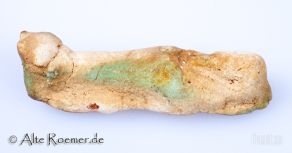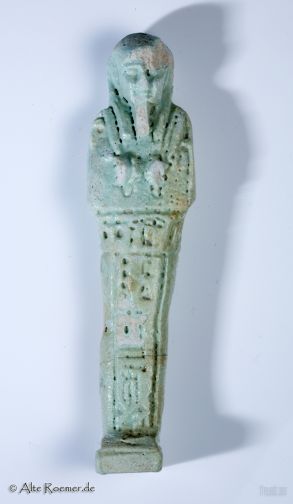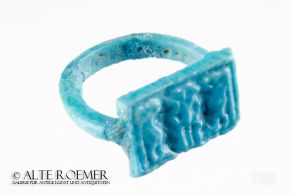Egyptian - Featured Objects - Photo gallery
Image database with photographs of ancient art and antiquities
Our image database provides photographs of ancient art and antiquities for press releases as well as for private use. All artefacts sold in our gallery are documented through professional photographs. The resulting image library contains numerous ancient Egyptian, Greek and Roman antiquities as well as ancient coins. The time span from Stone Age, over Bronze Age and Classical Antiquity until Late Antiquity is covered.The photo gallery aims at providing a vast visual archive equipped with filters and search tools. You are most welcome to search the constantly growing number of artefacts in the image library. We are also happy to authorize hyperlinks from your webpage / forum to the objects depicted in our gallery. For this purpose, please send us a short notification prior to placing a hyperlink. For almost every object high definition photographs are available and can be provided e.g. to document your collection or for scientific papers or popular science articles. If you are interested in using pictures for publications, print media or other purposes, please contact us and we will be happy to assist you.
-
 Zoomorphes koptisches Textilfragment
Zoomorphes koptisches Textilfragmentmit Darstellung von Vögeln und Tieren. Ein exzellentes Belegstück des horror vacui. Starke Farben.
Price: on request Osirisfigur aus Bronze
Osirisfigur aus BronzeSpätzeit-ptolomäische Epoche, menschliche Mumiengestalt mit Uräus-Krone und Königsbart
Price: on request Ushebti aus der frühen Ptolomäerzeit
Ushebti aus der frühen PtolomäerzeitIntensiv-grüne Fayence, sehr großes Detailreichtum. Höhe ca. 95mm, 4. Jh. v. Chr., frühe ptolomäische Periode.
Price: on request Musealer Ushebti mit Hieroglyphen
Musealer Ushebti mit Hieroglyphen22.-23. Dynastie, mit hieroglyphischer Inschrift. Typische Ausführung mit Stirnband und senkrechtem Hieroglyphenregister.Weiße Fayence, Höhe 10 cm.
Price: on request Ägyptischer Ushabti
Ägyptischer UshabtiStatuette aus der Ptolomäerzeit. Belegstück für die letzte Periode der klassischen ägyptischen Geschichte, welche mit der Übergabe Ägyptens an Alexander begann und mit Cleopatra VII endete.
Price: on request Ushebti aus der frühen Ptolomäerzeit
Ushebti aus der frühen PtolomäerzeitTürkise Fayence, sehr großes Detailreichtum. Höhe ca. 90mm, 4. Jh. v. Chr., frühe ptolomäische Periode.
Price: on request Ägyptischer Ushebti mit T-förmiger Inschrift
Ägyptischer Ushebti mit T-förmiger InschriftTotenfigur aus mintfarbener Fayence mit hieroglyphischer Inschrift, 28. bis 30. Dynastie, Spätzeit. 105mm hoch.
Price: on request Ushebti des Ptahhotep
Ushebti des PtahhotepÄgyptische Statuette in musealer Erhaltung. 400 bis 332 v.Chr., Spätzeit, 28. bis 30. Dynastie. 10,5cm hoch. Mit Hieroglyphentext: Der erleuchtete Osiris, Herr der Kraft, Gottes Diener, Ptahhotep, ...
Price: on request Ägyptisches Tauret-Amulett aus Fayence
Ägyptisches Tauret-Amulett aus FayenceAmulett der Nilpferdgestaltigen Göttin Tauret, der Göttin der Schwangeren und der Gebärenden. Intensive Farbgebung. Spätzeit, 26. - 30. Dynastie.
Price: on request Ushebti, Ptolomäerzeit
Ushebti, PtolomäerzeitSehr gute Erhaltung. Intensive Farbgebung, grün-weiße Fayence. Höhe 4,5 cm, 4 - 3. Jh. v. Chr., ptolomäische Epoche.
Price: on request Ägyptisches Amulett
Ägyptisches AmulettFayenceamulett aus Ptolemäischer Zeit, 323 v.Chr. bis 30 v.Chr. Sehr schöne Fayence in einem grün-cyan. 7mm x 5mm x 3mm.
Price: on request Ägyptisches Amulett
Ägyptisches AmulettFayenceamulett aus Ptolemäischer Zeit, 323 v.Chr. bis 30 v.Chr. Sehr schöne Fayence in einem Beigeton. 6mm x 5mm x 2mm.
Price: on request Ägyptisches Amulett
Ägyptisches AmulettFayenceamulett aus Ptolemäischer Zeit, 323 v.Chr. bis 30 v.Chr. Sehr schöne Fayence in einem blau-türkis. 5mm x 4mm x 2mm.
Price: on request Egyptian amulet of a lion headed goddess
Egyptian amulet of a lion headed goddessAttributed to Sekhmet, goddess of war and protection from illness. Very nice and detailed fayence work. Dating to the Third Intermediate Period to Late Period of Ancient Egypt.
Price: on request Egyptian New Year flask with ornamentation
Egyptian New Year flask with ornamentationHieroglyphic inscription expressing New Year wishes for Ptah at the beginning of the nile floodings. Important 26th dynasty piece associated with the Egyptian New Year rituals. The object is a fantastic example of the skilled workmanship and artistic quality of faience in ancient Egypt.
Price: on request Ägyptisches Plättchen mit Kartusche des Sethos I.
Ägyptisches Plättchen mit Kartusche des Sethos I.Doppelseitige Platte aus grüner Fayence aus dem Neuen Reich, ramessidisch, um 1290 v. Chr. Sphinx und Kartusche (Men-Maat-Re) und Namens-Kartusche mit dem Eigennamen Meri-en-Ptah.
Price: on request Skarabäus mit Kartusche des Chaneferre
Skarabäus mit Kartusche des ChaneferreSkarabäus mit Namens-Kartusche des Königs Chaneferre (Sobekhotep IV.). 13. Dynastie des Alten Ägyptens, ca. 1700-1680 v. Chr.
Price: on request Applique of the Horus son Duamutef
Applique of the Horus son DuamutefBright turquise fayence. Duamutef is one of the four sons of Horus, well-known from the Canopic jars. He had an important protective function for the dead. Egypt, 8th to 4th cent. BC.
Price: on request Egyptian heart scarab
Egyptian heart scarabBig beetle stone from the Late Period of Ancient Egypt. Scarabs of this kind have been placed next to the heart on mummies. Nice mint green fayence.
Price: on request Egyptian protective amulet and seal with Pataikos
Egyptian protective amulet and seal with PataikosDwarf god with knifes in his hands and Eye of Horus on his belly. The bottom side is made as a stamp seal with hieroglyphic inscription. Work of highest quality with fine details. Dating to the Third Intermediate Period.
Price: on request Stone statue of a seated Isis
Stone statue of a seated IsisVery fine condition, from an important London collection
Price: on request Scarab with breath of life
Scarab with breath of lifeThe Ankh on the bottom side of this ancient egyptian scarab symbolized life or afterlife. The symbol is framed by volutes.
Price: on request Cowroid with magical anra formula
Cowroid with magical anra formulaThe bottom side hieroglyphs of the anra type are to be interpreted as magical formula. The amulet dates to the Second Intermediate Period of ancient Egpyt.
Price: on request Scarab with cartouche
Scarab with cartoucheAmulet from the Late Period. The stamp is in great condition. This scarab is described in the catalogue of Irène Gautier-Vodoz.
Price: on request Scarab with two cartouches of Thutmose III.
Scarab with two cartouches of Thutmose III.Interesting amulet from the New Kingdom or a later period made in archaic style. This scarab is described in the catalogue of Irène Gautier-Vodoz.
Price: on request Scarab with cartouche of Thutmose III.
Scarab with cartouche of Thutmose III.Amulet from the New Kingdom for one of the most popular rulers in ancient Egyptian history. This scarab is described in the catalogue of Irène Gautier-Vodoz.
Price: on request Scarab with sphinx
Scarab with sphinxThe stamp depicts a human headed sphinx walking towards the Ankh symbol of life. The amulet should exert a protective function on the one carrying or owning it.
Price: on request Scarab with falcon headed god
Scarab with falcon headed godInteresting scarab amulet from the Second Intermediate Period. The seal shows a falcon headed creature facing an Egyptian cobra. This scarab can be found in the catalogue of Irène Gautier-Vodoz.
Price: on request Scarab from the Second Intermediate Period
Scarab from the Second Intermediate PeriodThe lower side shows a scarab, flanked by two uraeus snakes. 13th to 15th dynasty of ancient Egpyt. This scarab is described in the catalogue of Irène Gautier-Vodoz.
Price: on request Scarab with hieroglyphs arranged in a pattern
Scarab with hieroglyphs arranged in a patternThe lower side is skillfully decorated with hieroglyphs forming a geometric pattern. This scarab is described in the catalogue of Irène Gautier-Vodoz.
Price: on request Scarab with sphinx
Scarab with sphinxThe stamp depicts a sphinx with pharaoh headcloth walking towards the Ankh symbol of life. The amulet should exert a protective function on the one carrying or owning it.
Price: on request Scarab with the Red Crown of Lower Egypt
Scarab with the Red Crown of Lower EgyptThe scene can be seen as worship of the Deshret, the symbol of the kings of Lower Egypt during Hyksos times. An interesting piece of evidence of the Hyksos rule over Egypt.
Price: on request Egyptian scarab with papyrus plants
Egyptian scarab with papyrus plantsScarab amulet made of bright, almost white steatite. 13th to 15th dynasty. This scarab is described in the catalogue of Irène Gautier-Vodoz.
Price: on request Egyptian papyrus scepter amulet
Egyptian papyrus scepter amuletAmulet in the shape of a papyrus scepter. Late Period of Ancient Egypt. It symbolizes prosperity and youth. From the stock of a british private museum.
Price: on request Egyptian papyrus scepter amulet
Egyptian papyrus scepter amuletAmulet in the shape of a papyrus scepter. Late Period of Ancient Egypt. It symbolizes prosperity and youth. From the stock of a british private museum.
Price: on request Egyptian faience ring showing Bes and Taweret
Egyptian faience ring showing Bes and TaweretThe finger ring with its scene on the plate must have served a protective function for an expectant mother. New Kingdom, approx. 1550 to 1070 BC.
Price: on request

